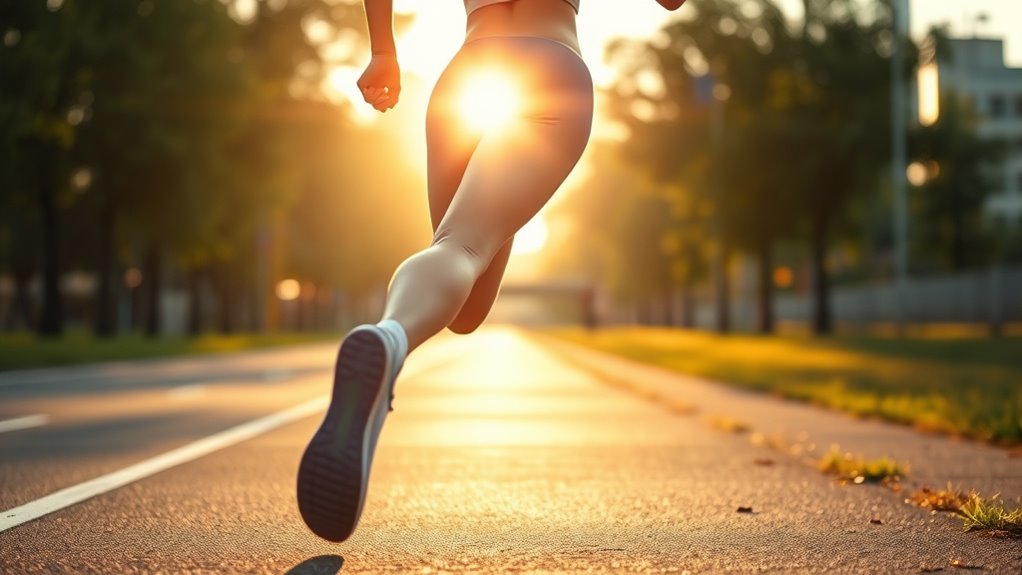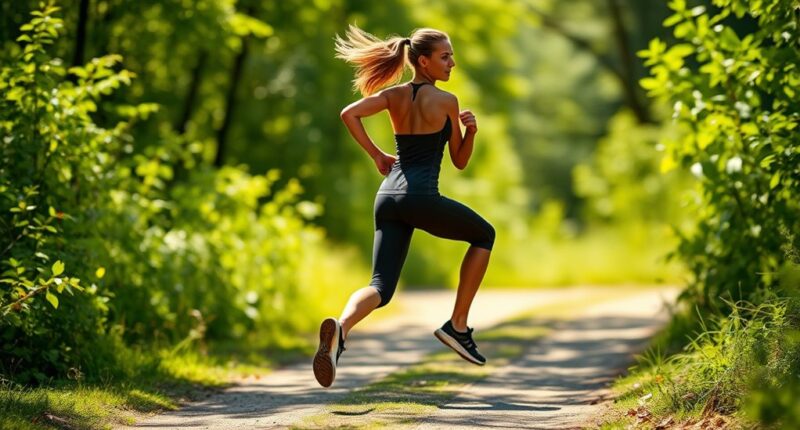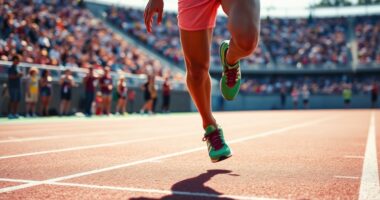Understanding the difference between mobility and flexibility helps you optimize your running performance. Flexibility is about how much your muscles can stretch passively, but mobility involves actively moving your joints through their full range with control. Runners need both: flexibility to prevent strains and mobility to maintain joint stability and efficient movement. Incorporating targeted exercises can improve both areas, helping you stay injury-free and perform better — keep exploring to learn how to combine them effectively.
Key Takeaways
- Flexibility refers to maximum muscle length, while mobility involves controlled movement through a joint’s full range.
- Runners need both flexibility for muscle elongation and mobility for joint control and stability.
- Static stretching improves flexibility but doesn’t enhance active movement or joint control necessary for running.
- Dynamic stretching and foam rolling boost mobility, improve tissue health, and prepare muscles for activity.
- An integrated routine combining flexibility and mobility work optimizes running performance and reduces injury risk.

Understanding the difference between mobility and flexibility is essential for optimizing your movement and preventing injuries. As a runner, knowing how to improve both can considerably enhance your performance and reduce recovery time. Flexibility refers to the range of motion in a joint or muscle, which you can increase through static stretching. However, focusing solely on flexibility isn’t enough; you also need to develop mobility, which involves the ability to move a joint actively through its full range of motion with control. This is where dynamic stretching and foam rolling come into play, helping you to prepare your muscles and joints for activity and maintain peak function.
Dynamic stretching is an active form of warm-up that involves movements mimicking the activity you’ll perform during your run. Instead of holding stretches, you move through a range of motion, gradually increasing intensity. For runners, this might include leg swings, lunges with twists, or high knees. Dynamic stretching boosts blood flow, elevates your core temperature, and improves joint mobility, making your muscles more pliable and ready for action. Incorporating these movements into your pre-run routine helps to activate the muscles you’ll use, decrease stiffness, and enhance overall mobility. Complementing this, foam rolling — a technique known as self-myofascial release — targets the fascia, the connective tissue that surrounds muscles and joints. Regular foam rolling can break up adhesions and knots in your muscles, improving tissue flexibility and reducing tightness. When combined with dynamic stretching, foam rolling prepares your muscles and joints to move freely, reducing the risk of strains or overuse injuries.
While flexibility training, like static stretching, can increase muscle length over time, it doesn’t necessarily improve your ability to move actively through your full range of motion during movement. That’s why mobility exercises are vital. Mobility drills often involve controlled, deliberate movements that enhance joint function and stability. For runners, working on mobility means doing exercises that allow your hips, ankles, and thoracic spine to move freely and efficiently. By consistently integrating dynamic stretching and foam rolling into your warm-up and cool-down routines, you can maintain or improve your mobility, ensuring your muscles stay responsive and your joints stay healthy.
Frequently Asked Questions
How Do Mobility and Flexibility Affect Running Performance?
Mobility and flexibility directly impact your running performance by enhancing muscle elasticity and joint range of motion. Incorporate dynamic stretching before runs to improve mobility, allowing smoother, more efficient movement. Increased flexibility helps reduce injury risk and muscle stiffness. When you focus on both, you can achieve better stride length, faster recovery, and overall endurance. So, stay consistent with stretching routines to optimize your running efficiency and prevent setbacks.
Can Improving Mobility Prevent Running Injuries?
Improving mobility can definitely help prevent running injuries by enhancing your movement efficiency and reducing strain on joints and muscles. While flexibility allows your muscles to stretch, mobility ensures your joints move freely through their full range of motion. When you focus on mobility, you create a better foundation for injury prevention, making your running safer and more effective. Don’t underestimate the power of optimized movement to keep you on the road longer.
What’s the Best Routine to Enhance Both Mobility and Flexibility?
To enhance both mobility and flexibility, you should incorporate dynamic stretching before runs to warm up your muscles and foam rolling afterward to release tension. Focus on movements that target your hips, hamstrings, and calves. Consistently doing these routines helps improve your range of motion and reduces injury risk. Make it a habit, and you’ll notice better performance and greater ease in your running strides.
How Do Age and Gender Influence Mobility and Flexibility Needs?
Like a fine wine aging with grace, your age impacts your mobility and flexibility, often leading to decreased range of motion over time. Gender differences also play a role; women tend to be more flexible, while men may need targeted stretching. To stay agile, adapt your routine to these factors, focusing on consistent mobility exercises that address your unique needs—because understanding these influences keeps you moving smoothly, no matter your age or gender.
Are There Specific Stretches for Different Types of Runners?
Yes, different runners benefit from specific stretches. For speed-focused runners, dynamic stretching like leg swings prepares muscles for quick movements, while marathoners might prioritize static stretching post-run to improve flexibility. Incorporate dynamic stretches before runs to activate muscles and static stretches afterward to increase range of motion. Tailoring your stretching routine to your running style helps prevent injuries and enhances performance.
Conclusion
Think of mobility and flexibility as the twin engines propelling your running journey forward. When you nurture both, you’re releasing a smooth, effortless glide, like a well-oiled machine dancing through the miles. Ignoring either can leave you stranded on the side of the road, lost in stiff, sluggish movement. So, embrace the dance of mobility and flexibility—they’re your secret keys to unlocking peak performance and running with the grace of a flowing river.









